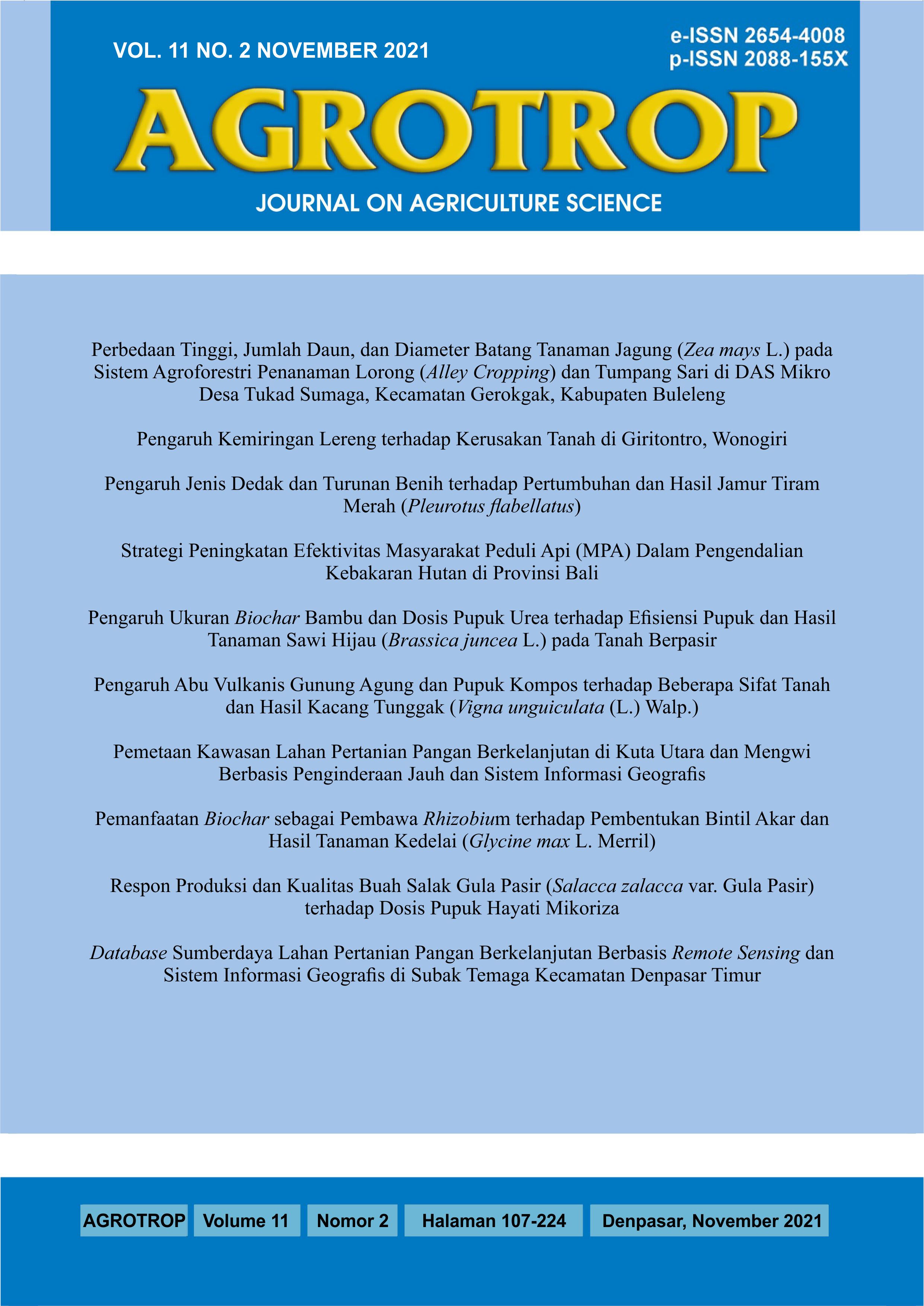Pengaruh Ukuran Biochar Bambu dan Dosis Pupuk Urea terhadap Efisiensi Pupuk dan Hasil Tanaman Sawi Hijau (Brassica juncea L.) pada Tanah Berpasir
Abstract
The Effect of Bamboo Biochar Size and Urea Fertilizer Dosage on Fertilizer Efficiency and Yield of Green Mustard (Brassica juncea L.) in Sandy Soil. Biochar is charcoal produced from incomplete combustion (carbonization). Biochar is a soil amendment agent that has long been known in agriculture which is useful for increasing soil productivity. This study aims to determine the effect of bamboo biochar size and urea fertilizer dosage on the efficiency of urea fertilizer and yield of green mustard (Brassica juncea L.). This research was conducted from May 2020 to September 2020 at the Experimental Garden of the Faculty of Agriculture, and at the Laboratory of Soil and Environmental Sciences, Faculty of Agriculture, Udayana University. The research design used was a completely randomized design (CRD) with 2 factorials and 3 replications. The treatment factors consisted of P0 = 0kg urea (control) (0 grams / pot), P1 = 100kg urea / ha (0.2 grams / pot), P2 = 200kg urea / ha (0.4 grams / pot), P3 = 300kg urea / ha (0.6 gram / pot), B1 = 0.25-2.00 mm, B2 = 2.38-2.83 mm, B3 = 2.83-3.36 mm. The parameters observed were levels of ammonium, nitrate, soil pH, microbial population, soil respiration, crop yields including fresh weight and oven dry weight of the plant. The results of the analysis showed that the effect of biochar and urea fertilizers interacted very significantly with the parameters of the microbial population and had no significant effect on the parameters of ammonium, nitrate, soil pH, soil respiration, plant fresh weight, plant dry weight, root fresh weight, root dry weight and efficiency. fertilizer. Biochar treatment has a significant effect on biological factors and fertilizer treatment affects soil chemical properties, crop yields are influenced by a single factor.
Downloads
References
Atmaja, I. W. D. (2017). Kajian Sifat Biologi Tanah Pada Beberapa Tipe penggunaan Lahan. Universitas Udayana.
Gani A. (2009). Biochar Penyelamat Lingkungan. Warta Penelitian dan Pengembangan Pertanian Vol. 31: 6.
Hardjowigeno, S. (2007). Ilmu Tanah. Penerbit Pusaka Utama, Jakarta.
Ibrahim, Y., & Tanaiyo, R. (2018). Respon Tanaman Sawi (Brassica juncea L.) terhadap Pemberian Pupuk Organik Cair (POC) Kulit Pisang dan Bonggol Pisang. Jurnal Agropolitan, 5(1):63-69.
Istarofah, & Salamah, Z. (2017). Pertumbuhan Tanaman Sawi Hijau (Brassica juncea L.) dengan Pemberian Kompos Berbahan Dasar Daun Paitan (Thitonia diversifolia). Bio-Site, 3(1).
Liescahyani, I., Djatmiko H., & Sulistyaningsih, N. (2014). Pengaruh Kombinasi Bahan Baku dan Ukuran Partikel Biochar terhadap Perubahan Sifat Fisika pada Tanah Pasiran. Berkala Ilmiah Pertanian, 1(1).
Lubna, D., & Sembiring, E. (2013). Emisi CO2 dan Penurunan Karbon Organik pada Campuran Tanah dan Kompos (Skala Laboratorium). Teknik Lingkungan, 19(1): 23-33.
Nigussie, A., Kissi, E., Misganaw, M., & Ambaw, G. (2012). Effect of Biochar Application on Soil Properties and Nutrient untake of lettuces (Lactuca sativa) Grown in Chromium Polluted Soils. American-Eurasian J. Agric & Environ.Sci.,12(3):369-376.
Pracaya. (2011). Bertanam Sayur Organik. Penebar Swadaya. Jakarta 123 (Diakses tanggal 21 Desember 2019).
Rahmadani, R. H., Roviq, M., & Maghfoer, M. D. (2016). Pengaruh Sumber Pupuk Nitrogen dan Waktu Pemberian Urea pada Pertumbuhan dan Hasil Tanaman Jagung Manis (Zea mays Sturt. Var. saccharata). Jurnal Produksi Tanaman, 4(1):8-15.
Triyono, A., Purwanto, & Budiyono. (2013). Efisiensi Penggunaan Pupuk -N untuk Pengurangan Kehilangan Nitrat pada Lahan Pertanian. Prosiding Seminar Nasional Pengelolaan Sumber Daya Alam dan Lingkungan, 1(2).











